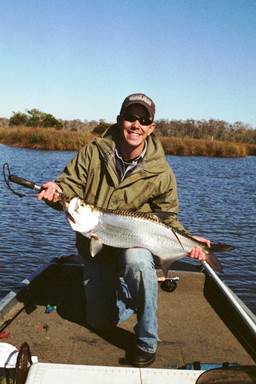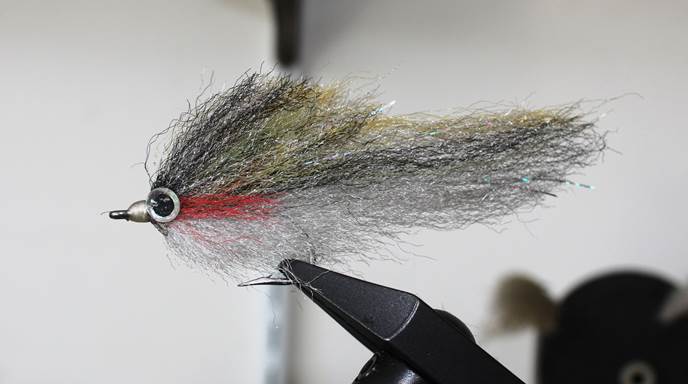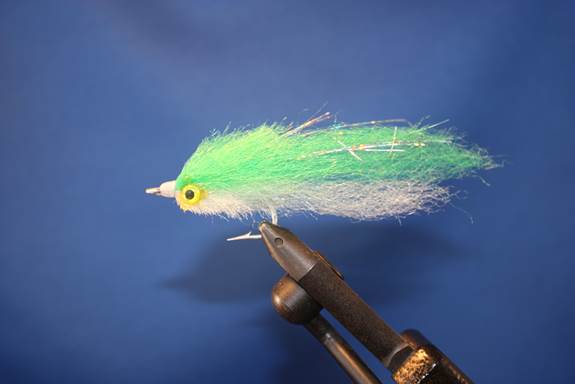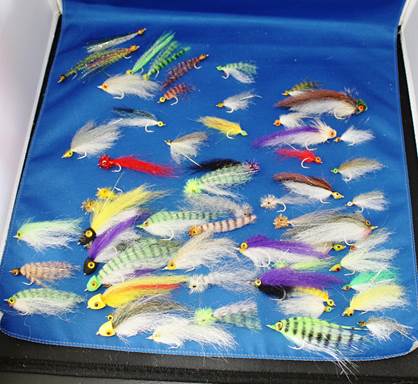SALTWATER CHRONICLES FLY FISHING ADVENTURES IN SALTWATER (part 10)
| Sysadmin Note |
|---|
| Part 9 can be found here |
Saltwater Gamefish of the Sebastian Area:
In this installment I will cover one of the most popular and sought after gamefish found in Florida and that is the tarpon or Silver King as it is often called.

Tarpon always bring a smile
Atlantic Tarpon [Megalops atlanticus] can grow to over eight feet in length and weigh over three hundred and fifty pounds, the males can live up to 35 years and the females can live to an age of 50 years. The tarpon are one of the most sought after fish is the southern coastal waters.
The Silver King got its name from its brilliant silver color, spectacular aerial leaps and hard fight they are classed as a mid-water predator mostly feeding on mullet, pinfish, ladyfish, marine catfish, Atlantic needle fish, sardines, shrimp and crab. They will feed both during the hours of daylight and darkness and the sallow their prey whole. Even though I have listed several of the tarpon's favorite meals I will tell you that they are opportunistic feeder and will feed on a great many marine minnows and small fish given the chance and will take flies off the surface.
Many fish prey on the smaller tarpon and the larger tarpon are preyed on by bull sharks, hammerhead sharks and alligators.
The tarpon reach sexually maturity during the sixth or seventh year at about four feet in length; they spawn offshore during May to July where the currents will carry the hatching larvae inshore to the nurseries of the lagoons, grass flat, saltwater and brackish water rivers.
When they first hatch the tarpon larvae resemble small eels rather than the familiar tarpon shape which is known to the anglers. The larvae grow through three stages and at the end of a six month period they now resemble the tarpon all anglers know and seek.
In the United States tarpon are not considered to be a food fish and in Florida you must obtain a special permit to kill a tarpon, however in Panama, Africa and the West Indies the tarpon is considered a delicacy. But the tarpon are not in danger and the world population multiplies 4.5 times every five years.
Tarpon are not dangerous to humans unless you try to land a green (fresh) hooked fish without properly fighting and getting the edge off its strength. Then you can have the tarpon in the boat or even in your lap which is generally bad for the angler, the boat and the equipment.
Before you try to land a tarpon make sure that the fish is properly tired out before bringing it alongside the boat. Now that you have landed your tarpon, taped it, and taken photographs you must make sure the fish is fully resuscitated before you release it. A tarpon this is released to soon can die of oxygen deprivation or may easily fall prey to sharks or gators and the Silver King is to valuable a trophy to waste.
Tarpon are found all along the coast including lagoons, saltwater and brackish water rivers and although most anglers seem to desire tarpon over eighty pounds I prefer the ten to sixty pound tarpon. The Sebastian Inlet area has plenty of large tarpon and the St Sebastian River is loaded with smaller tarpon during the winter months. Tarpon have a unique swim bladder which also functions as a practical respiratory organ (lung) which allows them to breathe and survive in water with low oxygen content.
As for those who wish to seriously pursue tarpon I suggest that you read A Passion For Tarpon, by Andy Mills. Andy will take you through the history of tarpon fishing with a fly rod and give you full understanding of the methods, tackle and flies that should be used to successfully hook this beautiful silvery fish.
Depending on the size of the tarpon being targeted an eight, ten or twelve weight rod and reel system will be required. Here in the Sebastian Inlet area during the winter months I am often using an eight weight and have landed tarpon up to ninety pounds with this system. Now if I see larger tarpon rolling I would switch to a heavier rod, however when you are catching a variety of species and you happen to hook a tarpon which you never saw coming it is kind of hard to switch to a heavier rod in the middle of the fight.
As for not seeing the tarpon if it is windy on the Indian River the water becomes churned up and discolored and you may not see the tarpon and on the St. Sebastian River the water is tea colored and you seldom see the tarpon that eats your offering.
In the Sebastian Inlet area the fly lines that I select will depend on the water depth that I am fishing in, but I always have a floating line, sink tip line, full sinking line and shooting heads rigged up for both my eight and ten weight system and I have caught tarpon on all of the lines that I have listed.
As for the flies, I will share a couple of my favorite tarpon patterns with you; however the number of different patterns that I have caught tarpon on is simply amazing. However I try to match my patterns with the current bait found in the water that I am fishing.

Mullet Minnow Streamer
- Hook: Mustad 34007 Sizes: 6/0-4
- Thread: White A
- Eyes: 3D-Silver with Black Center, applied with epoxy
- Wing/Body: Thin bunch of Silver/Grey EP Fibers, topped with Grey EP Fibers, followed by four to six strands of Silver Holographic Flash which is follow by Mullet EP Fibers.
- Gills: Small, short & thin bunches of Red EP Fibers tied on either side
- Belly: Silver/Grey EP Fibers

Chartreuse & White Tarpon Streamer
- Hook: Mustad 34007 Sizes: 5/0 to 4
- Thread: White A
- Wing/Body: White EP Fibers topped with Chartreuse EP Fiber and Silver Holographic Flash layered up the hook shank
- Belly: White EP Fibers layered up the bottom of the hook shank
- Eyes: 3D Yellow with black centers, applied with epoxy
Notes: Once the pattern is complete comb it out and trim to shape.

The Tarpon Toad created by Cary Merriman or Jack Gartside's Tarpon Bunny are two more popular flies for this exciting and highly sought after fish, but there are hundreds of effective tarpon flies all you have to do is chose your favorites.
Enjoy & Good Fishin'
| Sysadmin Note |
|---|
| Part 11 can be found here |
